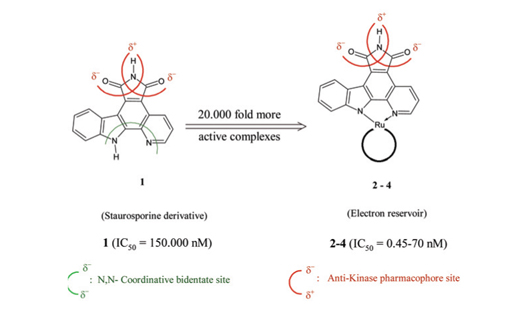Computational POM and DFT Evaluation of Experimental in-vitro Cancer Inhibition of Staurosporine-Ruthenium(II) Complexes: The Power Force of Organometallics in Drug Design
DOI:
https://doi.org/10.17344/acsi.2015.1357Keywords:
Cancer-Kinase (CK), antitumor agents, Ruthenium-Staurosporine complexes, DFT, Petra/Osiris/Molinspiration (POM) analysesAbstract
A computational Petra/Osiris/Molinspiration/DFT(POM/DFT) based model has been developed for the identification of physic-chemical parameters governing the bioactivity of Ruthenium-Staurosporine complexes 2-4 containing an antitumoral-Kinase (TK) pharmacophore sites. The four compounds 1-4 analyzed here were previously screened for their antitumor activity, compounds 2 and 4 are neutral, whereas analogue compound 3 is a monocation with Ruthenium(II) centre. The highest anti- antitumoractivity was obtained for compounds 3 and 4, which exhibited low IC50 values (0.45 and 8 nM, respectively), superior to Staurosporine derivative (pyridocarbazole ligand 1, 150 x 103 nM). The IC50 of 3 (0.45 nM), represents 20,000 fold increased activity as compared to Staurosporine derivative 1. The increase of bioactivity could be attributed to the existence of pi-charge transfer from Metal-Staurosporine to its (COd---NHd+) antitumor phramacophore site.

Downloads
Additional Files
Published
Issue
Section
License
Except where otherwise noted, articles in this journal are published under the Creative Commons Attribution 4.0 International License
